Identifying the Signs of a Dying Sedum
Oh no, it looks like your resilient little sedum is not living its best life! If you’ve noticed that your usually vibrant sedum has started to look a little under the weather, you’re right to be concerned. We’re about to delve into the common distress signals of these hardy succulents, and trust me, they aren’t just being dramatic!
Here’s the first tell-tale sign: the leaves. Sedum leaves are the mood rings of the plant world. If they’re changing color, especially to yellow or brown, then it’s a sign they’re not happy. It’s like they’re sending an SOS message – “Help me, I’m not getting what I need!” Discover the nuances of sedum care that could make all the difference.
Then there’s the texture. A healthy sedum is supposed to have firm and plump leaves – think of them as the succulent equivalent of a well-hydrated person. But when those leaves start feeling soft, mushy, or wrinkled, it’s a red flag. It’s screaming, “I’m either drowning over here, or I’m parched!”
And finally, let’s talk about vigor. Vigor, in the plant kingdom, is all about growth and resilience. When your sedum stops growing faster than an old Western movie plot, or it starts to droop like it’s carrying the weight of the world on its vulnerable shoulders, then it’s time for an intervention.
Like any good detective story, the signs are there, and it’s up to us to read them. The evidence (a.k.a. your sedum in distress) could use a little perking up. And just to give you a vivid picture, take a look at this snapshot of sedum not at their peak of health: 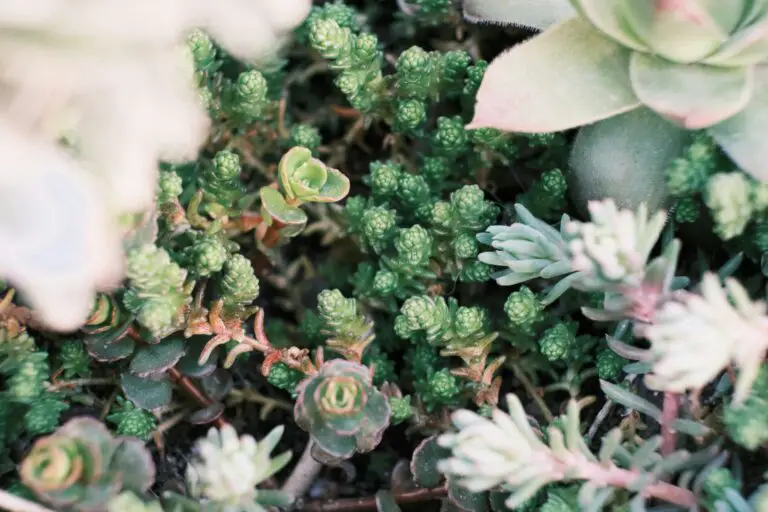
But fear not – it’s not all doom and gloom in the garden. You can turn your sedum’s frown upside down with the right care. For an excellent primer on keeping these succulents happy, check out this sedum care guide that’ll teach you the ropes of sedum care. Plus, for more intensive care tips and tricks, learning how to propagate these beauties might just revive them to their former glory!
Alrighty then, let’s roll up our sleeves and give these sedums a chance to thrive once more. With a bit of detective work and TLC, we’ll nip these issues in the bud, and you’ll be back to gazing at your thriving, serene sedums in no time!
Uncovering the Root Causes
So, you’ve noticed your usually resilient sedum looking a little under the weather, and you’re wondering, “Why is my sedum dying?” Well, you’re not alone in this garden drama. Imagine watching your favorite character in a show start to lose their spark – similar story with your sedum. Let’s dive into some of the common culprits behind your plant’s performance dip.
First off, overwatering is the equivalent of your sedum’s kryptonite. These succulent stars are designed for the desert-like conditions, not a tropical rainforest. Too much water leaves them drowning in soggy despair. Think of that time your well-meaning friend overfilled the goldfish bowl, and the poor thing could barely swim – it’s that kind of situation.
Now let’s chat about sunlight. Sedums need their sunbathing time just like any beach-goer looking for that golden tan. Without enough rays, your sedum becomes the pale, listless guest at the party – hardly the life and soul it usually is. They thrive in the full glare of the limelight, so give them their moment to shine.
Moving on to poor soil drainage. If your soil is more clingy than free-spirited, your sedum’s roots are probably throwing an SOS party. They crave a quick escape for moisture, much like a cat dodges a cuddle. Make sure their soil is as well-drained as your favorite colander so they can breathe easy.
Last but not least, let’s talk about extreme temperature fluctuations. Sedums are hardy, yes, but they don’t take well to sudden changes in weather. It’s like expecting you to walk from a cozy heated home straight into a snowstorm – not fun, right? These conditions can leave your sedum stressed, just like you’d be shivering and sprinting back inside.
Take a leaf out of the savvy gardener’s book by giving these areas a once-over, and who knows? Your sedum might just bounce back, ready to strut its stuff down the garden catwalk. If you’re eager to learn even more, there’s a fantastic resource for all things sedum at Better Homes & Gardens which will open in a new window for you.
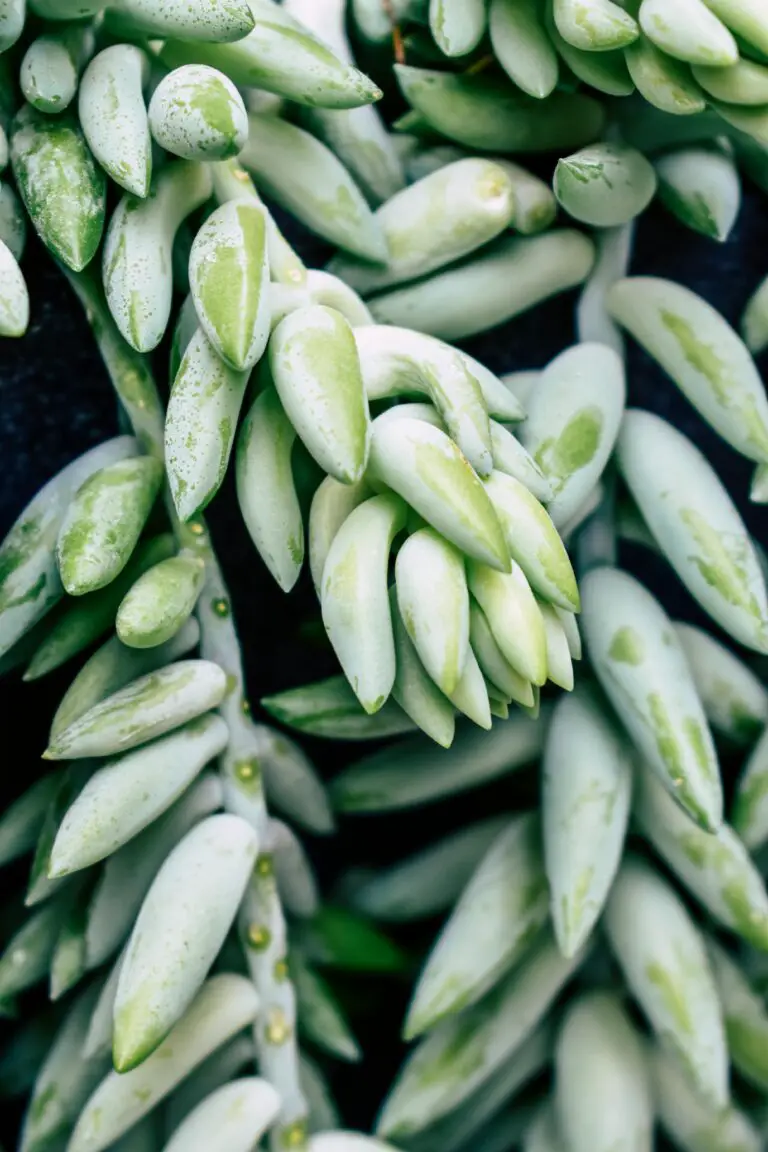
Water Woes: Overwatering vs. Underwatering
Striking the right moisture balance for your sedum isn’t just a good practice; it’s a survival skill for these drought-tolerant succulents. It’s like walking a tightrope—tilt too far in either direction, and your sedum might just wave a white flag. But fear not! You can become a hydration hero, rescuing your sedum from the brink with a few sage tips.
First off, let’s face the overwatering ordeal. Picture this: your sedum’s leaves are starting to look a bit more Michelin Man than sleek and svelte, and they feel squishy to the touch. That’s your cue; you’ve crossed into splash-happy territory. The soil is constantly soggy, and the roots are gasping for a break—they’re practically drowning! It’s time to ease up on the watering can and let the soil dry out between watering sessions.
On the flip side, under-watered sedum could be mistaken for a prop in a western movie—parched, wrinkled, and just begging for a drink. If your plant has taken on a withered, “left in the Sahara” vibe—or, let’s be real, even just looks a smidge thirsty—it’s pleading for hydration pronto. A well-timed soak can bring these resilient plants back from the edge.
Luckily, correcting the watering schedule isn’t rocket science. It’s all about observing and adapting. A good rule of thumb is to water when the top inch of soil feels dry. Be sure to provide a thorough drink during the growing season and cut back in the winter when your sedum is catching some Z’s. Still unsure if you’re on the right track? Roll up your sleeves and dive into our full sedum care guide for the nitty-gritty on nailing the watering regimen.
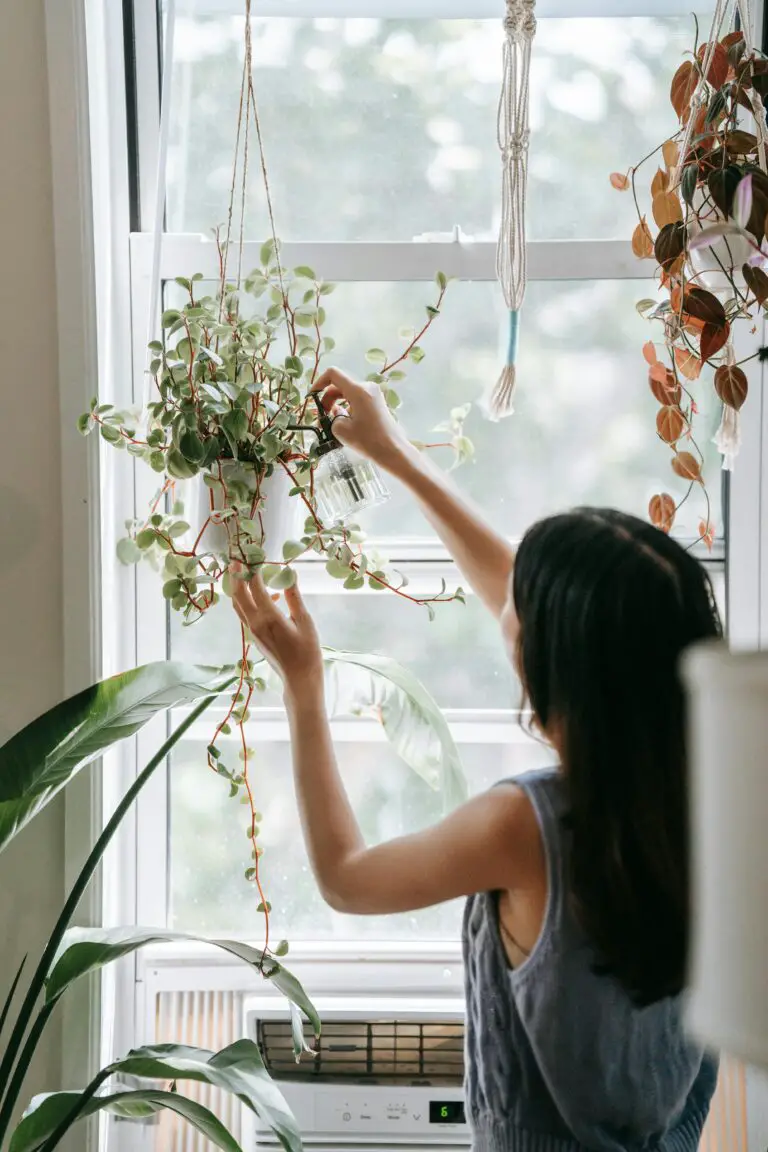
Remember, keeping your sedum thriving isn’t a guessing game—it’s about fine-tuning your care to match the plant’s needs. Address the water woes, and you’ll have a vigorous, vibrant sedum showing off its succulent splendor in no time.
The Battle Below: Root Rot and Soil Issues
Sedum plants are like the warriors of the succulent world—resilient and hardy. Yet, even the staunchest warrior can be felled by an unseen foe, and for sedum, this nemesis often lurks beneath the soil. Incorrect soil conditions can create the perfect breeding ground for root rot, a malicious condition that can sneak up and compromise your plant’s health. So how do you spot this stealthy adversary and what tactics can you employ to turn the tide? Let’s dive in.
Imagine you’re a detective, and you’ve been called to a garden crime scene. The victim: a sedum plant looking a little worse for wear. Your prime suspect is root rot, and it’s time to look for clues. Start by inspecting the roots; healthy sedum roots should be firm and white. If instead they’re brown, mushy, and have a musty smell, the plot thickens, and root rot is likely your culprit. This condition can be caused by overwatering or poorly draining soil which invites harmful fungi to feast on the roots.
The battle below the surface hinges on your next move. To outmaneuver root rot, begin by improving soil conditions—a strategic retreat to regroup and strengthen your defenses. If the current soil is dense and retains water like a sponge, it’s time to replace it with well-draining soil that’s mixed with gritty materials like pumice or perlite. This creates air pockets, allowing roots to breathe and water to flow freely, much like a well-crafted moat around a fortress.
When it’s time to repot, think of it as fortifying your sedum’s new stronghold. Carefully remove the plant, cut away any affected roots with sterile scissors, and whisper a battle cry as you plant it in its new, aerated domain. Remember, your watering can is a powerful ally when wielded wisely. Water your sedum only when the topsoil feels dry, and you’ll starve the root rot fungi of the moisture they crave.
In this fight for your sedum’s survival, knowledge is your weapon, and action is your shield. By understanding and remedying soil issues, you can turn the tide against root rot and ensure your sedum emerges victorious, ready to thrive once again.
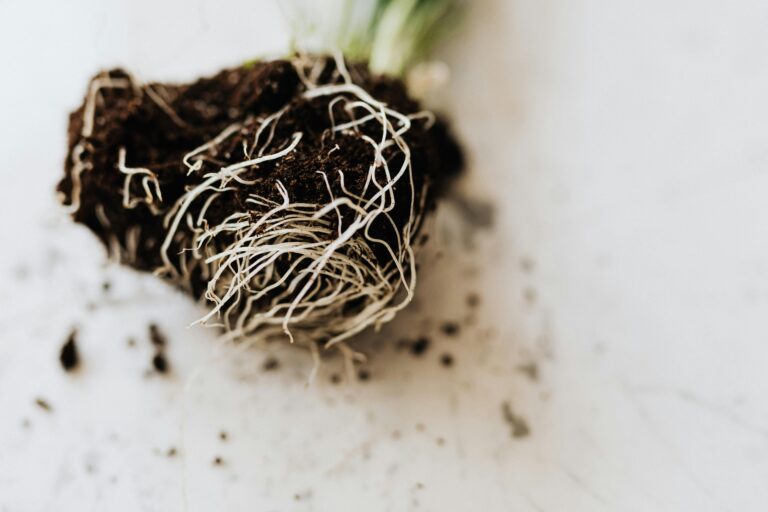
Pest Problems: Early Detection and Control
Imagine walking out to your beloved sedum garden and spotting an unsettling sight—leaves riddled with holes and a once vibrant plant looking rather defeated. Unfortunately, your sedum could be under siege from tiny invaders. Let’s shed some light on the common pests that consider your sedum plants a gourmet treat, explore how to spot trouble before it wreaks havoc, and discuss both the natural and chemical methods to send these pests packing.
Picture this: You’ve just gotten home from work, and you’re eager to check on your beautiful Stonecrop sedum, prized for its hardiness and drought-resistant prowess. But as soon as you lay eyes on it, there it is—an aphid infestation turning your succulent’s leaves into Swiss cheese! Right there, you’re witnessing one of the many culprits that attack sedums, including mealybugs, spider mites, and scale insects. These tiny marauders can suck the life out of your sedum’s leaves and stems.
A clear sign of pest infestation is a sudden change in your sedum’s appearance. Are the leaves turning yellow or brown? Do you see any sticky residue, or perhaps the dreadful webbing stretched between branches, a calling card of spider mites? It’s time to fight back.
To tackle these plant-pilfering pests naturally, encouraging beneficial insects like ladybugs and lacewings into your garden is a great start. These mini warriors consider aphids and other sedum-munching insects a prime feast. But if the situation has escalated beyond what Mother Nature can handle, you might need to intervene with insecticidal soaps or neem oil treatments.
For those times when the pest pressure is too great, and a stronger response is required, chemical pesticides can be a sedum saver. Always follow the instructions to the letter and apply with care—remember, we’re conducting a rescue mission, not a scorched earth campaign.
Effective pest control is all about timing. Like the ‘early bird’ axiom, catching pests early can mean the difference between a minor annoyance and a full-blown infestation. Regular inspection is your best defense against a sedum disaster. By keeping a vigilant eye and acting swiftly at the first sign of trouble, you can ensure your sedums stay healthy and continue to be the centerpiece of your drought-tolerant landscape.
For more top tips on keeping your succulents safe from slinking, sneaky snackers, check out our guide on embracing the power of proactive plant protection.
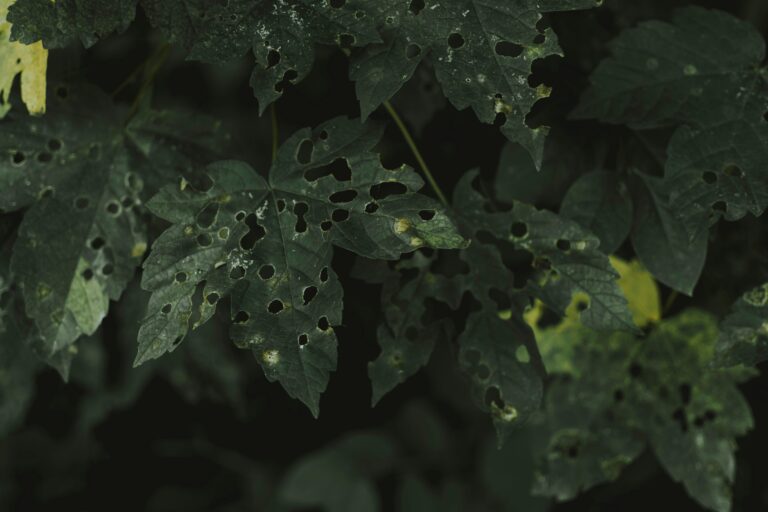
Disease Diagnosis: Fungal and Bacterial Threats
Imagine you’re strolling through your garden, humming a tune, when you spot your sedum looking sullen and sickly. Why is your usually vibrant and tough-as-nails sedum dying? Well, it turns out, these drought-lovers have a nemesis—fungal and bacterial diseases! Allow me to unravel this garden mystery and arm you with the know-how to tackle these plant pathogens head-on.
First up, let’s talk fungal foes. One of the most common culprits is powdery mildew, which dusts your sedum’s leaves with what looks like a sprinkling of white flour. It thrives in warm, dry climates—much to the chagrin of sedum enthusiasts. But here’s the twist: while it looks like a death sentence, it’s more of a cosmetic conundrum. With a good squirt of fungicidal soap or a homemade baking soda mixture, it’ll be bidding your garden goodbye.
Then there’s the insidious root rot, sneaking up from below. Often the aftermath of waterlogged soil, this dastardly disease causes your sedum’s roots to turn into a mushy brown mess. The key to avoiding this? Ensure your soil has excellent drainage and pull back on the watering. Thirst isn’t really in a sedum’s vocabulary.
Bacterial villains can also crash the party. Take, for example, the infamous bacterial leaf spot. This disease sprinkles black or brownish specks on your sedum’s foliage, sometimes causing the leaves to collapse in despair. These dappled invaders spread through splashes of water, so watering at soil level and providing proper air circulation can keep your sedum standing tall and proud.
Lastly, let’s not overlook the dreaded crown gall. It’s like the sedum’s plant version of the flu, causing unsightly tumors at the crown and roots. And while there’s no cure, removing the infected parts and improving cultural practices can help prevent this malady from taking hold. So, snip those galls away and dispose of them like last year’s fashion fads.
As daunting as these threats may sound, remember that a sedum is resilient. With the right attention and care, you can nurse your succulent back to splendor. It’s all about staying vigilant, acting fast, and creating a space where your sedum can thrive, unworried by the shadow of fungal and bacterial foes. Armed with this knowledge, you’re well on your way to restoring plant paradise!
Revitalizing Your Sedum: A Rescue Plan
Staring at your once lush, vibrant Sedum turning into a wilted specter can be disheartening for any plant enthusiast. Fear not, fellow green thumbs! It’s time to turn those plant woes into plant wows. Take a deep breath and prepare for a horticultural revival, as we embark on an emergency intervention to breathe life back into your sedum. Let’s make that transition from despair to repair!
Step 1: Prune the Problem
First things first—take those pruning shears in your hand. Your sedum may be suffering because of overgrown or dead foliage, which can lead to poor air circulation and pest issues. Snip away any brown, mushy leaves or stems, as these are the tell-tale signs of rot. Remember, the goal is to clear space for healthy growth. Think of it like trimming the sails of a ship to catch the perfect wind—except here, it’s about catching optimal health!
Step 2: Assess and Address the Soil Scene
Is your sedum’s soil more swampy than soothing? Overwatering could be the culprit. Give it a new lease on life by repotting into fresh, well-draining soil that’s fit for a succulent. Use a mix specifically designed for these drought-loving darlings—one that will say ‘adios’ to excess moisture and ‘aloha’ to aeration.
Step 3: Opt for Optimal Lighting
Sedums are sun worshippers; they flourish with just the right amount of solar embrace. Place your plant pal in a spot basking in bright, indirect light, and watch as it starts to perk up. Be cautious, though, as too much direct sunshine could turn your rescue mission into a sunburn saga. It’s all about balance, like getting the perfect tan without turning lobster red.
Step 4: Water Wisdom
Watering willy-nilly? Nope, that’s not on our watch. Overwatering is the highway to the danger zone for sedums. When it comes to hydration, it’s not about quantity but quality. Wait until the soil is dry to the touch before offering your sedum a drink. Treat it to a drought-and-drench routine, mimicking the natural environment of these desert denizens—a thorough soak and then nothing until it’s dry again.
Step 5: Fertilize, but Sparingly
A gentle nudge with fertilizer can encourage your sedum to get back on its metaphorical feet. However, moderation is key. A diluted solution of succulent fertilizer during the growing season can replenish any depleted nutrients without overwhelming your tenderly recovering plant.
Visual Guide to Revival
If you’re looking for a visual aid as you march on this recovery journey, a video tutorial can make all the difference. Follow along with this informative guide on sedum care that not only provides clear visual cues but also extra tips to ensure your green friend thrives once again.
So, roll up those sleeves and get to work. With these revival tips, your sedum doesn’t have to be a tale of sorrow; it can be a story of tomorrow, fully rejuvenated and flourishing with life and color once again. Keep at it, and soon enough, you’ll have the satisfaction of witnessing a botanical comeback that could rival any underdog story!
“`html
Preventative Measures: Keeping Your Sedum Thriving
Wish your sedum could talk and tell you exactly what it needs? Well, let’s decode its silent language and ensure those verdant leaves stay perkily aloft. Now, imagine you’re the detective in a garden mystery where the prime suspect is improper care. Our mission: crack the case of the languishing sedum with savvy care strategies.
We might not have a green “Sherlock Holmes” cap, but we’re about to deduce the optimum fertilization routine. Sedum, like any plant, has specific dietary preferences. Too little, and it starves; too much, and it gets bloated with nutrients. Picture this: you’re making a sumptuous meal for a discerning guest—your sedum. It craves a balanced diet, so aim for a slow-release fertilizer with a low nitrogen content. Spring is your cue; when the earth awakens, nourish your plant pal.
Pruning: Not Just a Haircut
Annual pruning isn’t just a trendy haircut, it’s a rejuvenating spa for your sedum. As autumn casts its golden hues, it’s time to give your plant a trim. This isn’t just about aesthetics; it’s about preventing the center from dying out and encouraging robust growth come spring. Like a well-pruned storyline, cutting back the dead stems makes room for an enthralling new chapter.
Seasonal Sedum Shifts
Lean close and imagine whispering to your sedum, “I’ve got your back, buddy, no matter the weather.” Adjust your care with the rhythms of the seasons—like syncing your playlist to suit your mood. In the scorching summer, your sedum’s thirst might spike, pleading for a splash more water. Yet, as winter’s chill rolls in, it dreams of drier roots to avoid a frosty demise. So, stay attentive and pivot your approach with the capricious climate dances.
Remember, vigilance and adaptability are your best allies in your quest to keep your sedum in high spirits. Now, armed with these tips, go forth and be the Florence Nightingale of the succulent world—nurturing and healing one sedum at a time.
“`
Frequently Asked Questions
Got a sagging Sedum on your hands? You’re not alone! Whether it’s a ‘Stonecrop’ looking sorry for itself or an ‘Autumn Joy’ that’s lost its joy, the struggle is real for Sedum stewards. But don’t fret! Let’s dig into some of the top head-scratchers that plant enthusiasts like you have when it comes to these succulent perennials.
Why is my sedum looking less than stellar?
It’s a common tale: one day, your sedum is the epitome of plant perfection, the next, it’s drooping like it’s had one foot in the compost heap. Light issues are the usual suspects. Too much? It’ll burn faster than a marshmallow at a bonfire. Too little? It’ll stretch out like it’s trying to find the sun with a telescope. Remember the Goldilocks principle: just right.
Is there a watering secret to sedum success?
Picture this: a sedum plant and water are in a relationship—it’s complicated. Overwatering is the equivalent of sending a hundred “I love you” texts in a single day—not cool. On the flip side, underwatering is like ghosting—equally damaging. Your sedum craves a balance. A drink when the soil is dry, and a drainage that’ll whisk away excess moisture like a plant-size umbrella.
Could pests and diseases be plaguing my plant?
Imagine your sedum rolling out the welcome mat for pests and diseases—it’s a garden party you didn’t plan for! Keep a watchful eye for uninvited guests like aphids, mealybugs, and the dreaded root rot. A healthy sedum is a fortress, but when weakened, it might as well hang a “Vacancy” sign for these troublemakers.
Is it too late to revive my sedum?
Sedums may play dead better than a possum, but there’s often hope! Giving them the ol’ snip-snip — cutting back dead parts — can encourage fresh, spritely growth. Relocating your green buddy for better light and less soggy soil can also make a world of difference. It’s not just a comeback; it’s a plant resurrection!
When should I really start worrying about my sedum?
Here’s the deal: if your sedum starts losing leaves faster than trees in autumn, or its stems are as mushy as overcooked zucchini, the alarm bells should ring. It’s a horticultural SOS that means immediate intervention is needed. But, if it’s just a few blemishes or a couple of lackluster leaves, breathe—it’s not the end of the garden as we know it.
Armed with the answers to these burning questions, you’re well on your way to transforming from a sedum sufferer to a sedum savant. So, keep a close eye on your leafy friend, flex that green thumb, and you’ll be the sedum whisperer in no time. And remember, sometimes a little plant TLC goes a long way!



